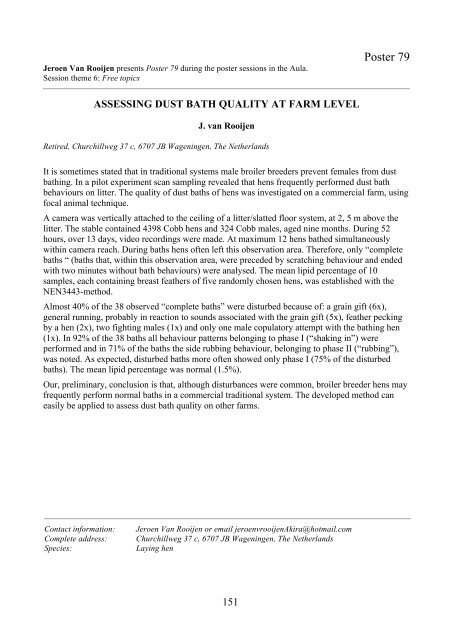Acknowledgements Book of abstracts - Publicaties - Vlaanderen.be
Acknowledgements Book of abstracts - Publicaties - Vlaanderen.be
Acknowledgements Book of abstracts - Publicaties - Vlaanderen.be
You also want an ePaper? Increase the reach of your titles
YUMPU automatically turns print PDFs into web optimized ePapers that Google loves.
Jeroen Van Rooijen presents Poster 79 during the poster sessions in the Aula.<br />
Session theme 6: Free topics<br />
ASSESSING DUST BATH QUALITY AT FARM LEVEL<br />
J. van Rooijen<br />
Retired, Churchillweg 37 c, 6707 JB Wageningen, The Netherlands<br />
151<br />
Poster 79<br />
It is sometimes stated that in traditional systems male broiler breeders prevent females from dust<br />
bathing. In a pilot experiment scan sampling revealed that hens frequently performed dust bath<br />
<strong>be</strong>haviours on litter. The quality <strong>of</strong> dust baths <strong>of</strong> hens was investigated on a commercial farm, using<br />
focal animal technique.<br />
A camera was vertically attached to the ceiling <strong>of</strong> a litter/slatted floor system, at 2, 5 m above the<br />
litter. The stable contained 4398 Cobb hens and 324 Cobb males, aged nine months. During 52<br />
hours, over 13 days, video recordings were made. At maximum 12 hens bathed simultaneously<br />
within camera reach. During baths hens <strong>of</strong>ten left this observation area. Therefore, only “complete<br />
baths “ (baths that, within this observation area, were preceded by scratching <strong>be</strong>haviour and ended<br />
with two minutes without bath <strong>be</strong>haviours) were analysed. The mean lipid percentage <strong>of</strong> 10<br />
samples, each containing breast feathers <strong>of</strong> five randomly chosen hens, was established with the<br />
NEN3443-method.<br />
Almost 40% <strong>of</strong> the 38 observed “complete baths” were distur<strong>be</strong>d <strong>be</strong>cause <strong>of</strong>: a grain gift (6x),<br />
general running, probably in reaction to sounds associated with the grain gift (5x), feather pecking<br />
by a hen (2x), two fighting males (1x) and only one male copulatory attempt with the bathing hen<br />
(1x). In 92% <strong>of</strong> the 38 baths all <strong>be</strong>haviour patterns <strong>be</strong>longing to phase I (“shaking in”) were<br />
performed and in 71% <strong>of</strong> the baths the side rubbing <strong>be</strong>haviour, <strong>be</strong>longing to phase II (“rubbing”),<br />
was noted. As expected, distur<strong>be</strong>d baths more <strong>of</strong>ten showed only phase I (75% <strong>of</strong> the distur<strong>be</strong>d<br />
baths). The mean lipid percentage was normal (1.5%).<br />
Our, preliminary, conclusion is that, although disturbances were common, broiler breeder hens may<br />
frequently perform normal baths in a commercial traditional system. The developed method can<br />
easily <strong>be</strong> applied to assess dust bath quality on other farms.<br />
Contact information: Jeroen Van Rooijen or email jeroenvrooijenAkira@hotmail.com<br />
Complete address: Churchillweg 37 c, 6707 JB Wageningen, The Netherlands<br />
Species: Laying hen
















